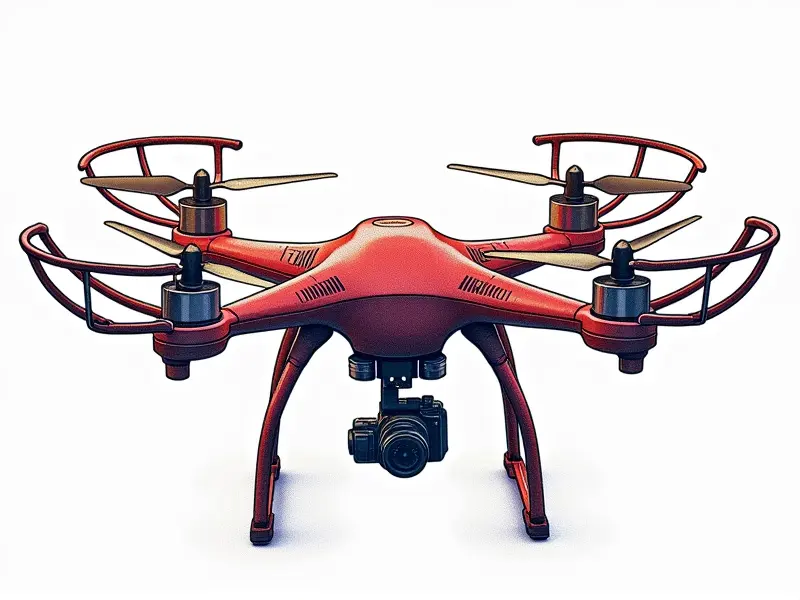What is OSD in FPV?

Understanding OSD in FPV Racing Drones
On-Screen Display (OSD) is a critical feature for FPV pilots, providing real-time information about your drone's performance and status. This article delves into the basics of OSD, its benefits, and how to set it up on your FPV racing drone.
What Does OSD Mean in FPV?
OSD stands for On-Screen Display, a feature that overlays essential flight data onto the video feed transmitted from an FPV camera. This information includes telemetry data such as voltage levels, GPS coordinates, altitude, and speed, which are crucial for safe and efficient flying.
The Basics of OSD for FPV Pilots
OSD systems typically consist of a microcontroller unit (MCU) that processes flight data from various sensors on the drone. This MCU then sends this information to an LCD screen or video transmitter, where it is displayed as text or graphical overlays.
Key Components of OSD Systems
- Microcontroller Unit (MCU): Processes flight data from sensors.
- Sensors: Measure voltage, GPS position, altitude, and more.
- LCD Screen or Video Transmitter: Displays the processed information on the FPV goggles.
How OSD Enhances Your FPV Experience
OSD significantly improves your FPV experience by providing real-time data that helps you make informed decisions during flight. This includes monitoring battery levels, maintaining altitude, and navigating accurately.
Benefits of Using OSD in FPV Systems
- Safety: Helps prevent crashes due to low battery or loss of control.
- Ease of Use: Simplifies navigation with GPS coordinates and altitude data.
- Performance Optimization: Allows you to monitor speed, heading, and other performance metrics.
Setting Up OSD on Your FPV Drone
Setting up an OSD system involves connecting the MCU to various sensors and configuring it through a software interface. This process can vary depending on the specific hardware used but generally follows these steps:
Step-by-Step Guide to Setting Up OSD
- Install Necessary Hardware: Connect the MCU, GPS module, voltage sensor, and other required components.
- Configure Software Settings: Use a configuration tool like Cleanflight or Betaflight to set up telemetry data.
- Test the System: Ensure all sensors are functioning correctly by testing in a safe environment before flying.
Why Every FPV Pilot Needs OSD
No matter your skill level, having an OSD system is essential for enhancing safety and performance. It provides critical information that can make the difference between a successful flight and a crash.
OSD Explained: Key Features and Benefits
- Battery Voltage: Monitor battery levels to avoid unexpected power loss.
- GPS Coordinates: Navigate accurately with real-time location data.
- Altitude Data: Maintain consistent altitude for smooth flight paths.
Essential Guide to OSD in FPV Systems
This guide covers everything you need to know about setting up and using an OSD system effectively. From choosing the right hardware to configuring settings, this comprehensive resource will help you get the most out of your FPV experience.
Tips for Maximizing Flight Data with OSD
- Customize Display: Adjust text size and position based on personal preference.
- Select Relevant Data: Choose which telemetry data to display based on your flight needs.
- Regular Maintenance: Keep sensors calibrated for accurate readings.
Mastering OSD Settings for FPV Flight
To fully leverage the benefits of an OSD system, it's important to master its settings. This involves understanding how different data points affect your flight and configuring them accordingly.
Advanced OSD Features
- Customizable Text: Display specific messages or warnings based on conditions.
- Multicolor Displays: Use color coding to highlight critical information.
- Data Logging: Record flight data for analysis and improvement.
Maximizing Flight Data with OSD
By optimizing your OSD settings, you can gain deeper insights into your drone's performance. This includes tracking battery usage patterns, analyzing altitude changes, and monitoring speed variations during different phases of flight.
Best Practices for Using OSD
- Consistent Monitoring: Regularly check telemetry data to ensure optimal performance.
- Data Analysis: Use recorded logs to identify areas for improvement in your flying technique.
- Community Support: Engage with other FPV pilots to learn advanced OSD configurations and troubleshooting tips.
Benefits of Using OSD in FPV Systems
The benefits of using an OSD system are numerous, from enhancing safety through real-time data monitoring to improving performance by providing valuable insights into your drone's operation. Whether you're a beginner or an experienced pilot, integrating an OSD system is a smart investment for any FPV setup.
Conclusion
Incorporating an On-Screen Display (OSD) system into your FPV racing drone setup offers significant advantages in terms of safety and performance. By understanding the basics of OSD, setting it up correctly, and maximizing its features, you can elevate your flying experience to new heights.

